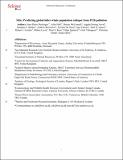Files in this item
Predicting global killer whale population collapse from PCB pollution
Item metadata
| dc.contributor.author | Desforges, Jean-Pierre | |
| dc.contributor.author | Hall, Ailsa | |
| dc.contributor.author | McConnell, Bernie | |
| dc.contributor.author | Rosing-Asvid, Aqqalu | |
| dc.contributor.author | Barber, Jonathan L. | |
| dc.contributor.author | Brownlow, Andrew | |
| dc.contributor.author | De Guise, Sylvain | |
| dc.contributor.author | Eulaers, Igor | |
| dc.contributor.author | Jepson, Paul D. | |
| dc.contributor.author | Letcher, Robert J. | |
| dc.contributor.author | Levin, Milton | |
| dc.contributor.author | Ross, Peter S. | |
| dc.contributor.author | Samarra, Filipa | |
| dc.contributor.author | Vikingson, Gísli | |
| dc.contributor.author | Sonne, Christian | |
| dc.contributor.author | Dietz, Rune | |
| dc.date.accessioned | 2018-10-11T12:30:09Z | |
| dc.date.available | 2018-10-11T12:30:09Z | |
| dc.date.issued | 2018-09-28 | |
| dc.identifier | 256100495 | |
| dc.identifier | 392b65a3-c25c-4f7f-a534-b0b1b3fbaebf | |
| dc.identifier | 30262502 | |
| dc.identifier | 85054145385 | |
| dc.identifier | 000446142200047 | |
| dc.identifier.citation | Desforges , J-P , Hall , A , McConnell , B , Rosing-Asvid , A , Barber , J L , Brownlow , A , De Guise , S , Eulaers , I , Jepson , P D , Letcher , R J , Levin , M , Ross , P S , Samarra , F , Vikingson , G , Sonne , C & Dietz , R 2018 , ' Predicting global killer whale population collapse from PCB pollution ' , Science , vol. 361 , no. 6409 , pp. 1373-1376 . https://doi.org/10.1126/science.aat1953 | en |
| dc.identifier.issn | 0036-8075 | |
| dc.identifier.other | Bibtex: urn:03bc22c49a6e450156d6d04b0e2043cf | |
| dc.identifier.other | ORCID: /0000-0002-7562-1771/work/49052080 | |
| dc.identifier.other | ORCID: /0000-0001-7575-5270/work/56052239 | |
| dc.identifier.uri | https://hdl.handle.net/10023/16189 | |
| dc.description | This research was supported by grants to J.-P.D. from the Canadian National Science and Engineering Research Council (NSERC) (PGSD3-443700-2013) and Aarhus University’s Graduate School and Science and Technology (GSST) and Department of Bioscience; and by funding from the Danish DANCEA program (MST-112-00171 and MST-112-00199); the Defra, Scottish and Welsh Governments (for CSIP/SMASS/CEFAS); and the Icelandic Research Fund (i. Rannsóknasjóður; grant no. 120248042). B.M. was supported by funding from NERC (grant no. SMRU 10001). This paper is a contribution from the BONUS BALTHEALTH project, which has received funding from BONUS (Art. 185), funded jointly by the EU, Innovation Fund Denmark, Forschungszentrum Jülich GmbH, German Federal Ministry of Education and Research (grant no. FKZ 03F0767A), Academy of Finland (decision no. 311966), and Swedish Foundation for Strategic Environmental Research. | en |
| dc.description.abstract | Killer whales (Orcinus orca) are among the most highly polychlorinated biphenyl (PCB)–contaminated mammals in the world, raising concern about the health consequences of current PCB exposures. Using an individual-based model framework and globally available data on PCB concentrations in killer whale tissues, we show that PCB-mediated effects on reproduction and immune function threaten the long-term viability of >50% of the world’s killer whale populations. PCB-mediated effects over the coming 100 years predicted that killer whale populations near industrialized regions, and those feeding at high trophic levels regardless of location, are at high risk of population collapse. Despite a near-global ban of PCBs more than 30 years ago, the world’s killer whales illustrate the troubling persistence of this chemical class. | |
| dc.format.extent | 4 | |
| dc.format.extent | 455318 | |
| dc.language.iso | eng | |
| dc.relation.ispartof | Science | en |
| dc.subject | QH301 Biology | en |
| dc.subject | DAS | en |
| dc.subject | NERC | en |
| dc.subject | BDC | en |
| dc.subject | R2C | en |
| dc.subject | ~DC~ | en |
| dc.subject.lcc | QH301 | en |
| dc.title | Predicting global killer whale population collapse from PCB pollution | en |
| dc.type | Journal article | en |
| dc.contributor.sponsor | NERC | en |
| dc.contributor.sponsor | NERC | en |
| dc.contributor.institution | University of St Andrews. School of Biology | en |
| dc.contributor.institution | University of St Andrews. Sea Mammal Research Unit | en |
| dc.contributor.institution | University of St Andrews. Marine Alliance for Science & Technology Scotland | en |
| dc.contributor.institution | University of St Andrews. Scottish Oceans Institute | en |
| dc.identifier.doi | https://doi.org/10.1126/science.aat1953 | |
| dc.description.status | Peer reviewed | en |
| dc.identifier.grantnumber | NE/R015007/1 | en |
| dc.identifier.grantnumber | Agreement R8-H12-86 | en |
This item appears in the following Collection(s)
Items in the St Andrews Research Repository are protected by copyright, with all rights reserved, unless otherwise indicated.

